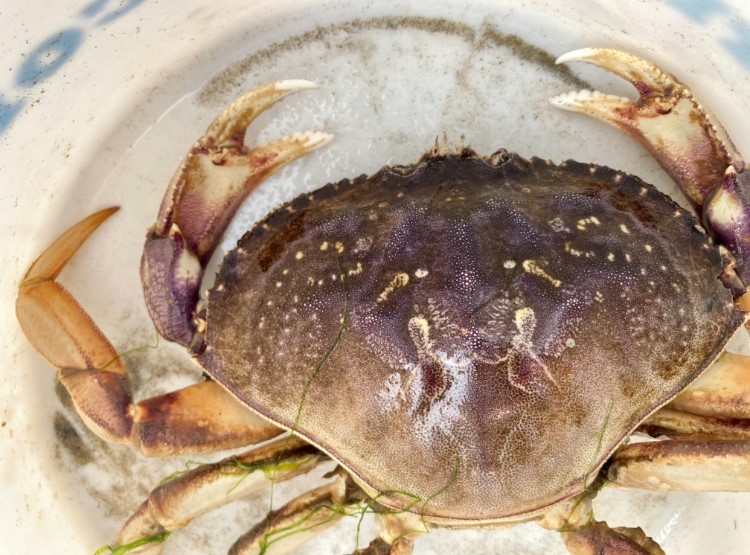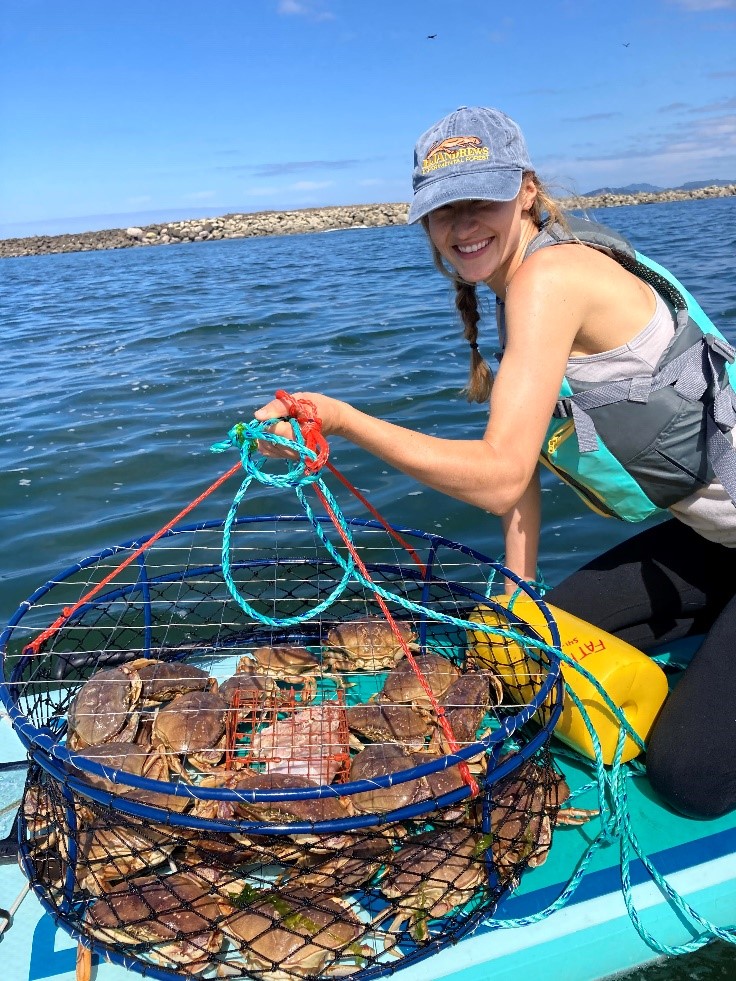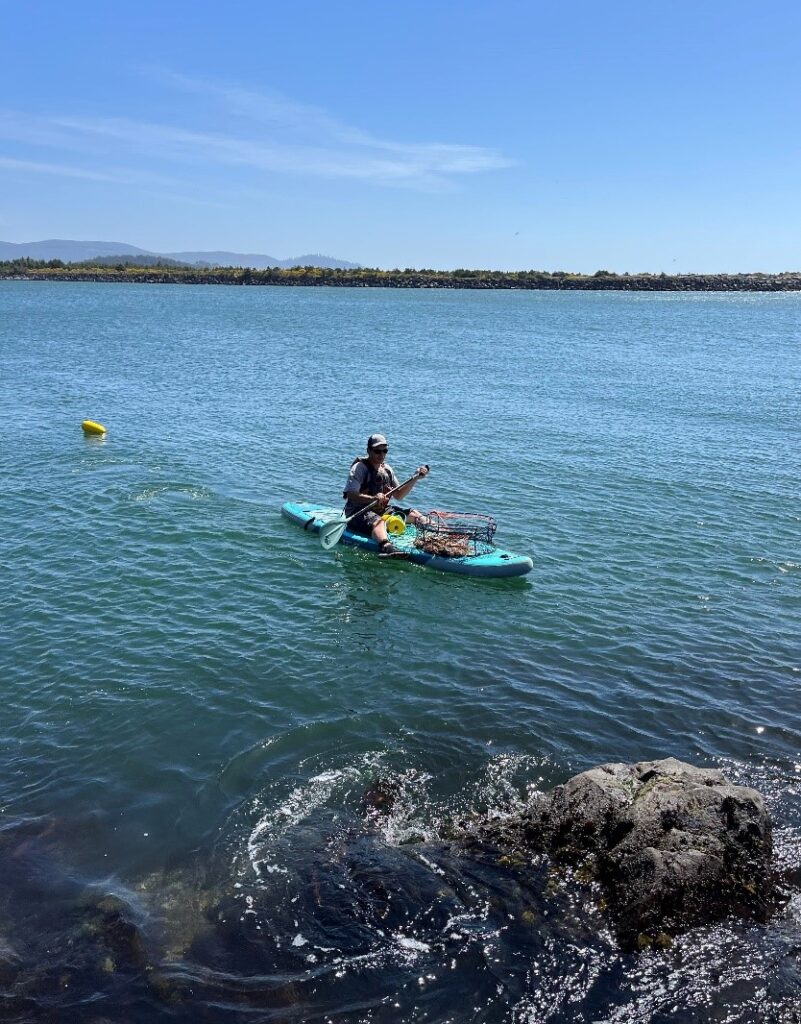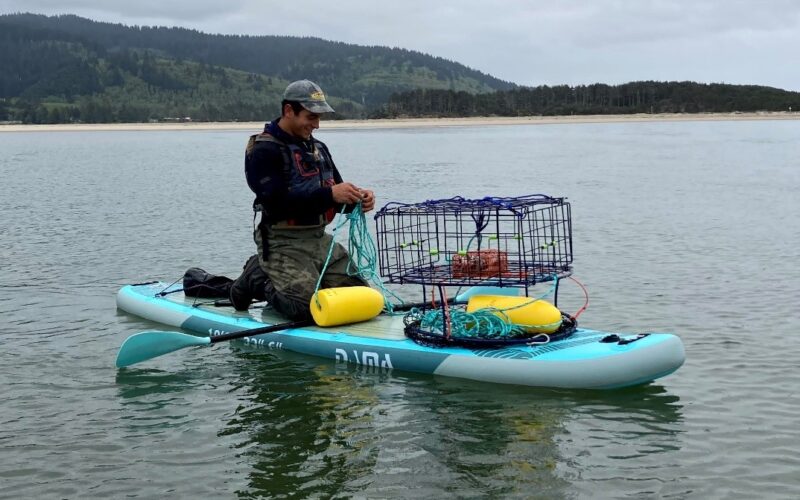Story and photos by LAUREN ZATKOS
Some people who think of Oregon immediately associate it with the iconic Dungeness crab. And this makes sense; as the most profitable fishery in Oregon, the coast is dotted with crabbing boats and colorful crab pot buoys. If you walk into any coastal restaurant, you are likely to see various forms of the shellfish on the menu, from whole steamed crab to crab cakes to Dungeness macaroni n’ cheese.

Most coastal visitors may also assume that owning your own boat or renting a charter is the only way to harvest the orange and purple crustacean, but this is not the case. If you have a paddleboard or kayak, you may be seafaring enough to catch your limit of Dungeness, no boat engine or gasoline required!
If you want to pursue Dungeness crab without the fuss of a boat, there are a number of factors to consider: gear type, bait, paddle device, location, and safety.
Gear, Bait, and Boards
Most bait and marina shops sell numerous types of crab pots, but it is important to pick one that is light enough for you to pick up and maneuver on your own. You will also need rope and a buoy to mark the location of your pot once it is submerged.
Once you have your lightweight crab pot purchased and tied up to your buoy, you will need to bait the trap. Typically, crab pots have some sort of bait compartment near the middle of the trap that you can fill with chicken or frozen fish. Some of the best luck we have had was by baiting the traps with our own frozen fish carcasses, leftover from after filleting a catch. Dungeness particularly seem to love lingcod carcass, but any fish will do. Any bait shop will sell something that the carnivorous crabs find appealing.

Last but not least, you will want a stable paddle boat for your ocean harvesting endeavors. Because even protected bays will still experience some wave action, it is important that you feel stable and secure in your kayak or paddleboard. Because you will be moving around to drop your crab pot into the water and later retrieve it, you should feel secure on your motorless boat of choice.
Location, Location, Location
There are excellent spots to crab all along the Oregon coast, including the bays of Netarts, Tillamook, Waldport, Coos Bay, and Newport, among others. While rock crabs are more prevalent along Oregon’s rocky coastal areas, Dungeness prefer sandy substrate. Adult Dungeness tend to cluster along the bottom of sandy bays to feed during high and low tides, so they can avoid predators that may be lurking in the open ocean. Crabs are still present in the estuaries in between tides, but water often moves in and out of these areas quickly during this tidal transition and the crabs tend to hunker down in the sand to avoid being swept out to sea. They particularly seem to like aggregating amongst patches of eelgrass, likely to hide from passing seals. The best time to crab these bays is at high tide during spring, summer, and fall, whenever there is a relatively small tidal exchange.
Tips While on Your Board
One of the easiest ways to catch Dungeness without a boat is by taking your paddleboard or kayak to the nearest sandy bay or estuary and dropping a baited crab pot as close as 15- to 20-feet offshore. While these crabs are plentiful in sandy estuaries, they do not spend time in shallow waters if they can avoid it. You can find Dungeness in the bays in water as shallow as 10 feet.
Start an hour before high tide, when waters are generally calmer (pending already calm weather) and paddle out to your targeted area. We like to keep our crab pots in front of us near the front end of our paddleboards, and you can place pots in the same area in a kayak. Using this method, you can easily reach forward, grab the buoy line near the pot, and lower the pot down into the water next to you. Once the pot is down on the sandy bottom, you can toss the rest of your line and the buoy into the water and paddle your way back to shore (or continue paddling around the bay for some gorgeous coastal views).

If you’ve picked a good spot, you can return to your trap in as little as 10 minutes to investigate your catch. Just paddle over to the buoy, grab the line, and pull fast! You do not want to slowly tip your pot, potentially scaring crabs out. It is a good idea to place the buoy on your board/kayak and spool the line in behind or on top of it, so it is not trailing in the water behind you. Once your pot is next to your boat, hoist it up into the front position on your board, and you’re ready to head back to shore with your catch.
It is always a good idea to check the local crabbing guidelines before going out, but in general, it is only legal to keep males that are at least 5 ¾-inch wide across the back. Consult the Oregon Department of Fish and Wildlife recreational crabbing resources online to help identify the differences between a male and female.
With a valid Oregon shellfish license (be sure to purchase before you head out), you may keep up to 12 male crabs per day. That is a lot of crab cakes!
Safety First
Any time you are on the ocean, there are numerous safety factors to be aware of:
- Importantly, you should always wear a life jacket while on the water. Bays can get choppy and make boards and kayaks unstable, even on blue-sky days.
- Always wear the ankle strap or life jacket strap that attaches your person to your flotation device, should you fall into the water.
- Be sure to check the tide chart and weather forecast for that day. Tides change quickly, as does the weather on the coast.
- Keep your pot line neat and away from your feet, even when you are quickly pulling in a loaded crab trap.
- Be aware of (motor) boats that you may be sharing the bay with.
Have fun, and happy crabbing!
Story published online exclusively for Oregon Coast magazine on July 13, 2023. Cover photo caption: Francisco unknots his buoy line before paddling out to throw in two baited crab pots.




